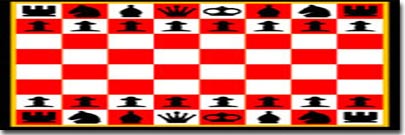Chess and the Laws of Physics
Excerpt from Time Travel in Einstein's Universe
By J. Richard Gott

Richard Feynman once noted that discovering the laws of physics is like trying to learn the laws of chess merely by observing chess games. You notice that bishops stay on the same color squares; you write this down as a law of chess. Later, you come up with a better law--bishops move diagonally. And, since diagonal squares are always colored the same, this explains why bishops always stay on the same color. This law is an improvement--it is simpler, and yet explains more. In physics, discovering Einstein's theory of gravity after knowing Newton's theory of gravity is a similar type of discovery. As another example, noticing that pieces don't change their identity in a chess game is similar to discovering the law of mass-and-energy conservation.
Eventually, say, you see a chess game in which a pawn reaches the other end of the board and is promoted to become a queen. You say, "Wait, that violates the laws of chess. Pieces can't just change their identity." Of course, it does not violate the laws of chess; you just had never seen a game pushed to that extreme before. In time-travel research we are exploring extreme situations in which space and time are warped in unfamiliar ways. That these time-travel solutions may violate "common sense" makes them intriguing.
In the same way, quantum mechanics and special relativity violate common sense beliefs and yet have been confirmed by many experiments. Quantum mechanics violates our expectations of everyday life because we are used to dealing with objects that are so large and massive that quantum mechanical effects are minimal. You have never seen your car "tunnel" out of a closed garage. You never find your car just suddenly sitting out on the lawn. If someone told you that such a thing could occur (with a small but finite probability), you might--before the twentieth century--have argued that the laws of physics do not allow such effects. And yet this has been shown to be true on the subatomic scale; a helium nucleus may tunnel out of a uranium nucleus in precisely this fashion, as shown by George Gamow. Quantum tunneling seems strange because in the ordinary world of large massive objects, quantum effects are hardly ever important. Gamow wrote a popular book to emphasize this point, called Mr. Tompkins in Wonderland (now reprinted with the wonderfully quirky name Mr. Tompkins in Paperback). It shows how the world would look to us if the velocity of light were only 10 miles per hour and if quantum effects were important on everyday scales. Hunters would have to aim at fuzzy tigers that could not be located exactly. And you would always be losing your car when it tunneled unexpectedly outside your garage (not to mention those car keys we lose so easily). If you were used to seeing such things, they might not seem strange.
Time travel seems strange because we are not accustomed to seeing time travelers. But if we saw them every day, we might not be surprised to meet a man who was his own mother and father*. Learning about whether time travel could occur in principle may give us new insights into how the universe works-and even how it got here.
* How this can happen is described in the short story "All You Zombies—" (1959) by Robert Heinlein. [Ed.]
J. Richard Gott III is a professor of astrophysical sciences at Princeton University
COPYRIGHT NOTICE: Copyright (c) 2001 by J. Richard Gott III. Reproduced by permission of Houghton Mifflin Company. All rights reserved.











